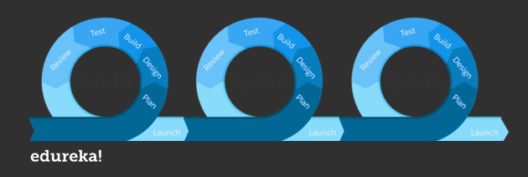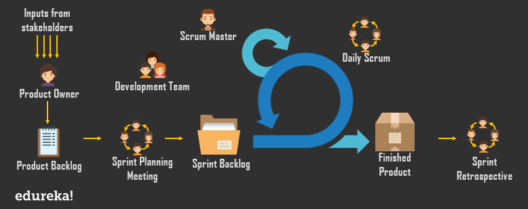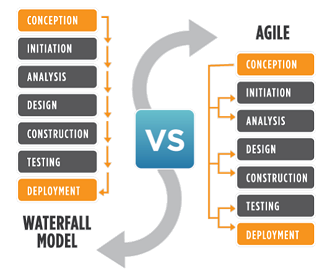PMP Certification Training
- 89k Enrolled Learners
- Weekend/Weekday
- Live Class
Business entities perform daily to achieve their goals; the thought of achieving the goals is a motivating factor for any organization. To reach the ultimate destination, they make use of different technologies, process, and strategies. Such a practice is called Agile Project Management. Below article will help you understand the basics of Agile Project Management.
Let us get started then,
An individual or collaborative enterprise that is carefully planned to achieve a particular aim is called a Project. It has a defined start date and end date with proper scope and resources. Projects are unique, they don’t occur repeatedly, but the tools and process used to achieve it are universal. Projects can be seen in different forms like software development, construction of a building, and implementation of the complex hardware system. But the efficiency of a project is measured based on the delivery time, feasibility, estimated budget, and cost.
Project Management is the application of different tools, process, skills, and resources, ideally to achieve the objectives of a Project. A Project Management has generally accepted five steps, those are
A formally written plan will be received either from a client or within an organization. When the proposal is approved, the planning stage will be initiated by a project manager. He will have multiple discussion with different individuals and teams to collect information and to finalize the time frame, budget, and feasibility of the project. Project plans are then discussed and approved after making necessary changes if any.
The project will be executed based on the project plan, and it will be supervised and controlled to make sure that it is not drifting away from its objectives. The supervision and monitoring are performed by project managers, team leads, high-level managers, and other stakeholders of the project. Project Sign Off is the acceptance of the project by either the client or the one who raised the requirement. This is done through a post-review meeting to ensure all the task mentioned in the project plan are achieved and it’s satisfactory, most cases there will be demo or testing.
Let us continue with this Agile Project Management article and take a look at the following pointer:
Agile is considered as one of the widely accepted and successful types of project management, mostly seen in the software industry. This methodology is best suited for projects that are iterative and incremental.

This involves a lot of collaborative efforts between cross-functional teams and their clients or the stakeholders to deliver the solutions for dynamic requirements. Agile possess its values and principles from Agile Manifesto, A declaration cemented in 2001 by 13 Industrial Leaders.
Scrum is a framework for project management that emphasizes accountability, teamwork, and iterative progress towards a well-defined goal. It comes under the broader umbrella of agile project management.

Typically roles like product owner, developer, and scrum master are the roles which are seen in a scrum system. In a scrum system project are completed based on sprint, scrum framework are suitable for a team which has less than seven members.
Kanban is another popular agile framework which was developed on the production line of the Toyota factories in the 1940s. It aims to deliver high-quality result by visualizing the whole process so that bottleneck can be figured out early in the development. Relying on six general practices, those are
Originated from the Japanese manufacturing industry, lean aims at maximizing the customer’s profit by minimizing waste. Its focuses on creating more value by using fewer resources. Wastes are classified into three categories, which are Muda, Mura, and Muri.
The traditional way of project management methodology, working linearly. The process flow from the design phase, and the progress flows downwards in one direction- like a waterfall. In this method, advancement to the next step is possible only after the completion of the current phase.
A Project Management methodology first introduced by engineers in Motorola in 1986. It aims to improve the quality of identifying the process which is not working correctly and eliminating those from the process, numerous quality management tools are used in this method.
Let us continue with this article and move to the next bit,
Agile methodology is an incremental and iterative approach; it is used for software development. In the agile approach, development and testing are done concurrently in the software development life cycle. It’s a collaborative approach and possesses excellent flexibility in the execution time.
In an agile methodology, communication between Business, Stakeholders, Developers, and Clients often meet to make necessary changes in the project and also to report the progress in the work done. As per the agile manifesto cemented in 2001 by 13 industry leader’s there are four values and 12 principles which drive the agile methodology.
The agile methodology uses the scrum process that allows delivering results in the shortest time, always work with the fact knowing that requirements keep on changing. Scrum fosters a self-organized, cross-functional team. The delivery system is different in scrum and agile, scrum always releases into the production on every week but in pure agile, it will be more frequent. Each time range is denoted as a sprint in a flexible system which uses scrum process. In a scrum system Courage, Focus, Commitment, Respect, and Openness are the foundation for a team’s processes and interactions.
Moving on to the final bit of this Agile Project Management article,
Agile methodology is considered as the new age mantra for successful project management; Waterfall methodology is the traditional project management methodology. It depends on the type of project to choose the method. Let’s take a look at the difference between Agile and Waterfall
In Agile methodology, the project is divided into achievable parts within a different time, an iterative and incremental approach. it enjoys a lot of flexibility. In this methodology, different phases can be done concurrently, like development and testing. The agile method tends to have repeated phases many times, there will be multiple design, development and testing scenarios.Agile Promotes a collaborative approach fostering cross-functional team. Dynamic projects find it’s easy to run in agile methodology,

On the other side, in Waterfall Methodology, a project is divided into a different phase like feasibility, planning, design, building, testing, production, and support. It resembles a real waterfall because the stage once and the process flow downwards thus making it more rigid. The waterfall method works through a stringent sequential process; it’s ideal for projects that have well-defined objectives and requirements, as well as projects that are required to be completed within a time frame agreed upon.
If you found this “Agile Project Management” article relevant, check out the PMP Certification Training Course by Edureka, a trusted online learning company with a network of more than 250,000 satisfied learners spread across the globe.
Find out our PMP Training in Top Cities/Countries
| India | Other Cities/Countries |
| Bangalore | UK |
| Hyderabad | US |
| Pune | Canada |
| Chennai | Australia |
| Mumbai | Singapore |
| Kolkata | Saudi Arabia |
Got a question for us? Please mention it in the comments section and we will get back to you.
 Thank you for registering Join Edureka Meetup community for 100+ Free Webinars each month JOIN MEETUP GROUP
Thank you for registering Join Edureka Meetup community for 100+ Free Webinars each month JOIN MEETUP GROUPedureka.co